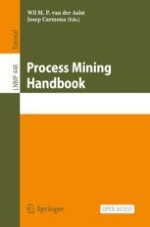Open Access 2022 | Open Access | Buch

Process Mining Handbook
herausgegeben von: Wil M. P. van der Aalst, Josep Carmona
Verlag: Springer International Publishing
Buchreihe : Lecture Notes in Business Information Processing
Open Access 2022 | Open Access | Buch

herausgegeben von: Wil M. P. van der Aalst, Josep Carmona
Verlag: Springer International Publishing
Buchreihe : Lecture Notes in Business Information Processing
This is an open access book.
This book comprises all the single courses given as part of the First Summer School on Process Mining, PMSS 2022, which was held in Aachen, Germany, during July 4-8, 2022.
This volume contains 17 chapters organized into the following topical sections: Introduction; process discovery; conformance checking; data preprocessing; process enhancement and monitoring; assorted process mining topics; industrial perspective and applications; and closing.